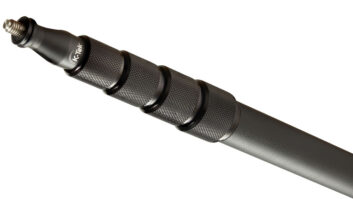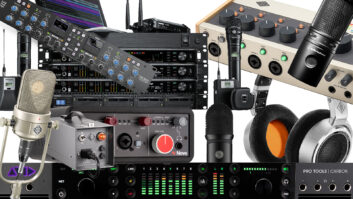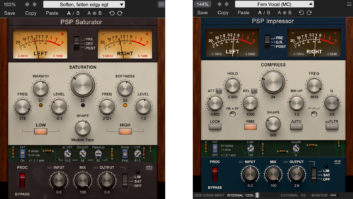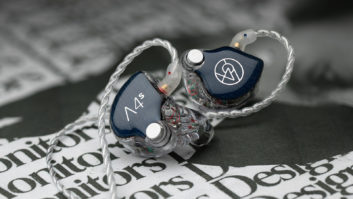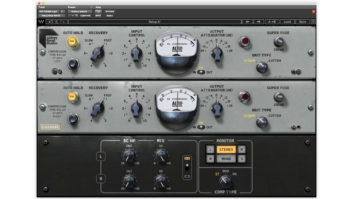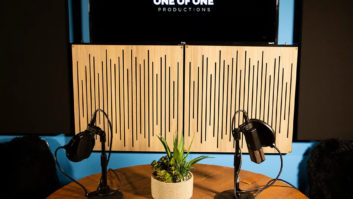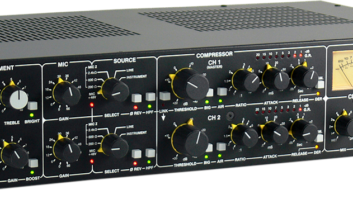
Tubes, valves, bottles, thermionic emitters or elektronenröhren — no matter what you call them, these 19th-century inventions are venerated in the professional audio and audiophile worlds. Musicians, especially electric guitarists, love playing through a good tube amp for its sweet sound. And recording engineers like to use tube gear alongside modern equipment for added warmth and to get that pleasant overloading sound.
Building tube-based equipment implies extra expense and special design considerations: Tube gear requires multiple power supply voltages, including high voltages not necessary in equivalent solid-state gear. Proper air ventilation is required as tubes get hot, and good shock-mounting is crucial because glass tubes are fragile and can develop microphonics, affecting audio quality. Tube gear also requires bulky transformers — tubes must be matched to the low-impedance requirements of pro audio. In addition, tubes’ performance characteristics change and degrade during their lifetimes, and circuit design must allow for this eventuality.
So why bother with this fussy antique technology? Because a well-designed tube audio processor using the best components and new tubes sounds like nothing else. Luckily, newer modern gear designs, along with higher-quality tube manufacturing, continue to keep these descendants of 100-year-old relics as useful, viable and current as the latest DAW/software music production systems. With that in mind, we bring you the latest in tube-based outboard gear, including a dozen units released since January 2004, plus a few sneak previews. We are focusing on straight-ahead signal processors; stand-alone microphone preamplifiers and DI boxes are excluded.
Aphex‘s (www.aphex.com) Model 230 Master Voice Channel ($799) is a single-channel analog preamplifier and voice processor, which features Aphex’s RPA™ (Reflected Plate Amplifier) circuit in which a vacuum tube amplifier is operated at a constant and very low plate voltage to maintain electron migration and transconductance. The circuit permits adding a tube amplifier’s desired euphonic color within a solid-state circuit. The 230 combines many of Aphex’s stalwart processors in one unit, such as Easyrider™ compressor, Logic Assisted™ gating, and Aural Exciter® and Big Bottom® psychoacoustic effects. Voice recording problem-solvers include onboard split-band deessing, a fully parametric EQ and a phase rotator feature that makes the asymmetrical waveform of certain voices more symmetrical, resulting in a much richer and more detailed sound. I/Os include AES, S/PDIF and optical digital outputs capable of up to 96 kHz, word clock I/O and a jack for a “cough” switch.
ART Twin Compressor System (TCS)
The Twin Compressor System™ (TCS) from Applied Research and Technology (www.artproaudio.com, $295) has opto-isolator and VCA compressors for a wider selection of compression styles. A 16-position knob selects preset compression configurations; there are also full manual controls of all settings. The TCS has an expander gate with a continuously variable high/lowpass shelving filter. TCS’ Stacked feature allows the opto-compressor to be configured in series with the solid-state compressor. Front panel controls for each channel include ¼-inch 1-megohm impedance instrument input jack and rotary gain control; attack, release, threshold and ratio compressor controls; noise-reduction threshold and variable noise-reduction shelf EQ for the expander/gate; preset selector; Tube Harmonics switching; and output level.

Drawmer 1968 Mercenary Edition
The Drawmer (dist. by TransAudio Group, www.transaudiogroup.com) S3 3-band stereo optical compressor offers precision gain control of each band for exacting spectral balance of any audio program. In addition to input and output transformers, there are 10 tubes (eight X ECC83s and two X 12BH7s) running Class-A in this three-rackspace unit. The gain-reduction elements are light-dependent resistors housed in temperature-controlled “ovens” to maintain their calibration standards for improved compressor operation and repeatable performance. Two knobs control how the three bands are split up: The Low range divides the audio into two compressors at any crossover point between 50 Hz to 1 kHz. There is also a Big mode for the bass compressor section. The High range uses a third compressor for an adjustable frequency range above 1 kHz, including a switchable Air Band mode. VU meters feature a switchable peak mode to monitor transient level information and rescale (+10 dB or +20 dB), in which levels up to +30 dBm can be measured accurately. MSRP: $8,500 to $9,000.
Coupling J-FETs and tubes in a single compressor is a marriage made in sonic heaven. This concept is well-plied in the 1U Drawmer 1968 Mercenary Edition J-FET/Valve Compressor ($2,150), where transistors are used for super-quick, clean and responsive peak limiting, while the valve gain output stages offer choices from pristine to thick and syrupy stereo bus compression. Features include easy-to-read VU meters that glow red when approaching clip; a +10dB Rescale VU Meter mode for monitoring super-hot levels; switchable highpass filter in the detector path to prevent excessive pumping from low-frequency energy; and six preset and resettable attack and release time settings.

D.W. Fearn VT-7
D.W. Fearn (www.dwfearn.com) relies on triode Class-A amplifier circuits from the VT-2 mic preamp and VT-4 EQ for the amplifiers in the new VT-7 ($4,400) dual-channel compressor. An arcane yet precise method of gain reduction is used: pulse width modulation with solid-state control circuitry. Two independent channels are linkable for stereo; inputs are bridged and balanced line-level, while the outputs are transformer-balanced line-level. Maximum gain reduction is rated at 25 dB. In addition to controls for threshold, attack, release and gain, there is a single multiparameter control (labeled Harder on one side and Softer on the other) that crossfades between two extremely different sets of attack and release times, compression ratios and other normally non-user — adjustable internal circuit parameters.

Groove Tubes Glory Comp
The Groove Tubes (www.groovetubes.com) Glory Comp ($3,495) is a single-channel all-tube variable transconductance dynamics processor. (Known for smooth and linear operation, variable transconductance is the same gain-changing scheme used in the vintage Fairchild 670 unit.) Compression ratios start at 1:1, with three more incremental steps before reaching 2:1, 3:1, 4:1 and 6:1; the unit offers standard attack, release and threshold controls. Release time is adjustable from 10 ms to 2 seconds, with a choice between logarithmic and linear release curve characteristics. Glory Comp uses several high-quality, ceramic multi-decked rotary switches for its controls, permitting easily repeated setups. Other features include a built-in adjustable low- and high-frequency sidechain filter; a fully differential and floating design; dual isolated output taps on a proprietary output transformer for interfacing both -10dBV and +4dBu equipment without sacrificing the unit’s sonic quality and low-noise performance; and the Glory knob, which, as it is rotated away from the earth position and toward the heaven side, adds low-order even harmonics to the compressed signal for a fatter and apparently louder sound without electrical level increase. Multiple Glory Comp units can be linked together in a master/slave arrangement for multichannel recording or 5.1 mixing.

Mercury Recording Equipment EQ-P1
The EQ-H1 ($2,100) and EQ-P1 ($2,400) tube program equalizers from Mercury Recording Equipment (www.mercury-rec.com) are re-creations of the rare Pultec equalizers. Preserving the original ideals and specifications of the 50-plus-year-old Pultec EQs are the main design and manufacture concerns. The units offer transformers and balanced I/Os, a passive EQ section and a single-ended gain tube makeup amplifier. Just like the originals, the interaction of the passive boosting and attenuating shelving EQs (which don’t rely on negative feedback), the transformers, tubes and other amplification circuitry make up the sound. These units have XLR I/Os (rather than Pultec’s terminal strip), 600-ohm operating I/O impedance, power-on/off toggle switch and jewel incandescent light indicators — all like the original Pultecs. The H1 uses 12AX7 and 12BH7 tubes. The Mercury EQ-P1 is the brother to the H1 and has one modernization: a user-switchable interstage transformer that was in the signal path in the original Pultec EQP. At the flip of a switch, users will get the vintage Pultec sound or, without the transformer, a more open, airy quality. The EQ-P1 has a different amplifier than the EQ-H1, and the two units sound different in the same application. The P1 uses 12AX7 and 12AU7 tubes.

MindPrint EN-VOICE MK II
The MindPrint (www.mindprint.com) EN-VOICE MK II ($799) is an updated version of the 1U EN-VOICE channel strip. The unit offers a mic preamp with +48-volt phantom powering, -20dB pad, an XLR mic input, ¼-inch line input and ¼-inch Hughes & Kettner instrument input, plus an 80Hz lowcut filter and a 3-band fully parametric equalizer. The soft-knee tube compressor has a separate Tube Saturation control with indicator, plus eight preset attack and release combinations. Other features include balanced XLR line I/Os, a switching mode power supply that works anywhere in the world, a 12-LED meter indicating input level, balanced insert jack and a compressor sidechain input with a 300Hz, 6dB/octave filter before the detector. Optional digital I/O is available via the DI-MOD USB expansion module.
Pendulum‘s (www.pendulumaudio.com) Quartet II Mercenary Edition ($5,250) is not an update or replacement of the company’s popular Quartet, but a complement to it. The unit has a strikingly different combination of design elements than the original Quartet, allowing many new options for carving unique sonic characteristics. To change the input amplifier’s gain structure on the Quartet II, users can switch between two input transformers for a turns ratio of either 1:5 or 1:10. Mic input impedance is also switchable between 1.5k ohms or 10k ohms, letting users dial in proper microphone loading to optimally match any mic to the unit. Independent gain and output controls permit overdrive of the tube stage to vary the preamp’s harmonic content. Other features include a 3-band, passive/aggressive inductor-based equalizer, in which the Aggressive mode alters the harmonic content of the EQ circuit; a Delta-mu compressor (derived from the ES-8), where changing the actual gain of a tube amplifier affects compression; and a dual-mode J-FET/MOSFET brickwall peak limiter. The EQ can be routed in front or after the Delta-mu compressor, and all four elements can be patched and used independently.
The 3U PAL Plus MkIII preamp/limiter from Requisite Audio Engineering (www.requisiteaudio.com) is available in single- or dual-channel models. Front panel mic preamp controls include a mic feedback control to reduce the amount of internal negative feedback within the mic preamp stage. In addition to output level and peak-reduction limiter response controls, the limiter also has a feedback control to drastically change its sound. Of special interest is the choice between two power supplies: the standard OPS-2 or the optional TPS-2 all-tube supply housed in a 3U chassis — enough room for transformers, tube rectifiers, oil and polypropylene filter capacitors. The tube supply causes the unit to sound smooth, while the solid-state supply considerably hardens up the overall sound. Other features include hi-Z instrument input, output polarity reverse, 10dB output boost for ribbon mics and separate VU and gain-reduction meters. Price: $3,600 to $7,250, depending on mono/stereo and supply.
The Summit Audio (www.summitaudio.com) FeQ-50 passive tube/solid-state parametric EQ is so new, there are no pictures or prices yet. Packed into a half-rackspace is a fully passive LC (coils and capacitors) design using solid-state and tube signal paths. The FeQ-50 is a single-channel, 4-band semi-parametric EQ with highpass filter. Each band has sweepable gain of ±14 dB with a center detent at 0 dB. Bands have six selectable frequencies with the two middle bands offering switchable Q (wide and narrow) by toggling between two different inductor coils in the equalizer circuitry. Low and high bands are selectable between peaking and shelving. The highpass filter has a knee at 80 Hz with a 12dB per octave roll-off. Both XLR balanced and ¼-inch unbalanced inputs are handled by a Neutrik Combo jack. The FeQ-50 has solid-state and tube outputs individually buffered and available at separate XLRs and ¼-inch jacks.

Tube-Tech SMC 2BM
Tube-Tech‘s (www.tube-tech.com) SMC 2BM ($6,595) is a stereo multiband tube compressor based on the SMC 2B and designed specifically for mastering. The SMC 2BM adds matched 12-step, gold-plated resistor gain controls to guarantee channel-to-channel accuracy and repeatability within 0.1 dB — an important requirement for the exactitudes of the mastering engineer. The crossover divides the stereo program into low, mid- and high bands with 6dB/octave networks and 12 selectable frequencies. Sidechain controls employ 31-position detent potentiometers, and the unit includes variable crossover points for precision control of all three bands of opto-compression. There are independent threshold, ratio, attack, release and gain controls for each band.

Universal Audio LA-610
The LA-610 Classic Tube Recording Channel ($1,795) is Universal Audio‘s (www.uaudio.com) 610 mic pre and EQ section backed with a Universal Audio/Teletronix LA-2A — style T4 opto-compressor. The T4 cell, the gain-reduction engine used in this unit and the famed LA-2, is a combination of an electroluminescent panel and custom-manufactured photo-resistors encased together. The T4 cell gives both of these compressors their program-dependent behavior and signature sound. Three 12AX7A, 6072A and 6AQ5 tubes complete this original MT Putnam design. Other noteworthy features include mic pre with variable impedance switching; ¼-inch instrument DI; front panel switching for bypass, limit or compress modes; classic passive high/low equalizer; and hand-assembly in the U.S.
Barry Rudolph is an L.A.-based recording engineer. Visit his Website at
www.barryrudolph.com.
